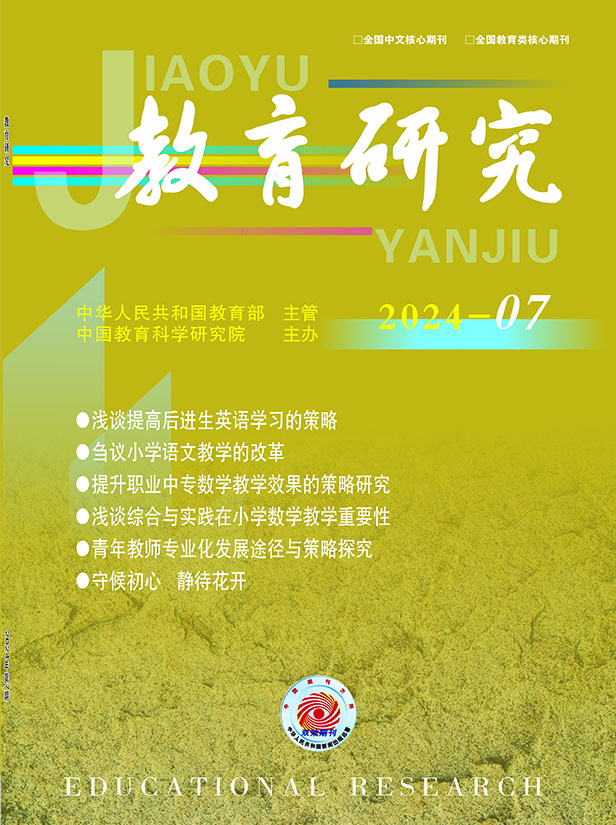刊名: 教育研究
Educational
Research
主办: 中国教育科学研究院
周期: 月刊
出版地:北京市
语种: 中文;
开本: 16开
ISSN: 1002-5731
CN: 11-1281/G4
邮发代号:
2-277
投稿邮箱:jyyj79@126.com
历史沿革:
现用刊名:教育研究
创刊时间:1979
该刊被以下数据库收录:
中国人文社会科学引文数据库(CHSSCD—2004)
核心期刊:
中文核心期刊(2008)
中文核心期刊(2004)
中文核心期刊(2000)
中文核心期刊(1996)
中文核心期刊(1992)
About English teaching in senior high school
【作者】 董晓梅
【机构】 云南省昭通市昭阳区第一中学
【摘要】【关键词】
Abstract: Classroom teaching is the main way for students to learn English. But in senior high school, a lots of probelms still exsit in the English teaching , especially in the teaching of reading and writing. In the paper, the importance and methods of reading and writing will be further discussed. Key words: reading, writing, techniques.
Introduction: Classes should be learner-centered, with meaningful, functional activities, often, classes begin by finding out what the students don’t know. The basic principle will be used in the teaching of reading and writing.
Section One——How to teach reading
I. Why to teach reading
There are many reasons for getting students to read English texts is an important part of the teacher’s job.
Reading texts provide good models for English writing, provide opportunities to study language vocabulary, grammar, punctuation, and the way to construct sentences, paragraphs and texts. Finally, good reading texts can introduce interesting topics, stimulate discussion, excite imaginative responses and be the springboard for well-rounded, fascinating lessons widely .
II. What kind of reading should students do?
When the teachers give reading class to students, they should notice a balance——a balance to be struck between real English on the one hand and the students’ capabilities and interests on the other. There is some authentic written material which beginner students can understand to some degree: menus, timetables, signs and basic instructions.
III. What are the principles behind the teaching of reading?
i) Permit Students To Read
No one has learned to swim by practicing the skills of backstrokes, flutter kicks or treading water while staying on the edge of the swimming pool. Yet, in the teaching of reading teachers often do just that. Rather than let the students into “the water”, teachers keep them in skills books learning rules about letters, syllables or definitions of words rather than letting them into the book itself, permitting them to be immersed in the language which comes from the authors as the readers try to reconstruct the written message. ii) Encourage students to respond to the content of a reading text, not just to the language.Of course, it is important to study reading texts for the way they use language, how many paragraphs they contain and how many times they use relative clauses. But the meaning, the message of the text, is much more important.
iii) Encourage students to guess or predict
Readers’ guesses or predictions are based on the cumulative information and syntactic structure they have been learning as they have been reading. Therefore, their guesses are more often than not appropriate to the materials.
iv) Match the task to the topic
Once a decision has been taken about what kind of reading text the students are going to read, teachers need to choose good reading tasks—the right kind of questions and useful puzzles, etc. Asking boring and inappropriate questions can undermine the most interesting text. Section Two——How to teach writing (Developing correctness in students’ writing)
“Students learn to write by writing, and they learn to write correctly by writing, revising, and proofreading their own work”——with some help or direction from the teacher when it is necessary.
We spend hours at night with papers——I’m not sure the students get as much from it as the time I spend on it.”
These comments by senior high school English teachers discussing the process of marking student papers reflect the dissatisfaction and frustration of many teachers over the problem of dealing with the errors in student writing——the obvious mistakes in spelling, punctuation——Traditionally, teachers have worked to correct errors in two ways: by teaching grammatically correctness through exercise in grammar texts; by pointing out all errors when making student papers.
Most students find it very dispiriting if they get a piece of written work back and it is covered in red ink, underlings and crossing-out. It is a powerful visual statement of the fact that their written English is terrible.
Some techniques can be used in dealing with the errors in student papers:
i) Selectivity
Rather than engage in intensive error-correction when responding to student writing, teachers are encouraged to adopt a more moderate approach to error. If the teacher over-corrects the students’ mistakes, the students would be likely to focus on errors instead of ideas. Students are more likely to grow as writers when the teacher’s primary purpose in reading student papers is to respond to content.
ii) Error-analysis
Another method for working with student error, one that can be especially fruitful for teachers, is to approach it from an analytic perspective.
iii) Publish Student Writing
The final basic strategy is publishing. Students need a reason for laboring over a draft until it is perfect; the urge to see oneself in print can be a powerful drive toward revision and proofreading.
Conclusion: As teachers to the students who are in senior high school, they should learn to turn students’ hard work toward supporting the language strengths students already have, proving students with a feeling of success, finding materials and planning classroom experiences will turn students on to reading and writing, the reading and writing will develop with much greater ease than it does at the present time.
Reference:
Gu Xueliang, The Basic Technical Training in English Teaching, Hangzhou University Press, 1998.
Wilga M.Rivers & Mary S. Temperley, A practical guide to the teaching of English as a second or foreign Language, New York: Oxford University Press, 1978
Smith F. Understanding Reading (2d ed), New York: Holt, Rinehart and Winston, 1978
David Freeman&Yvome S. Freeman,A Roadto Success for Language,New York:OxfordUniversityPress


